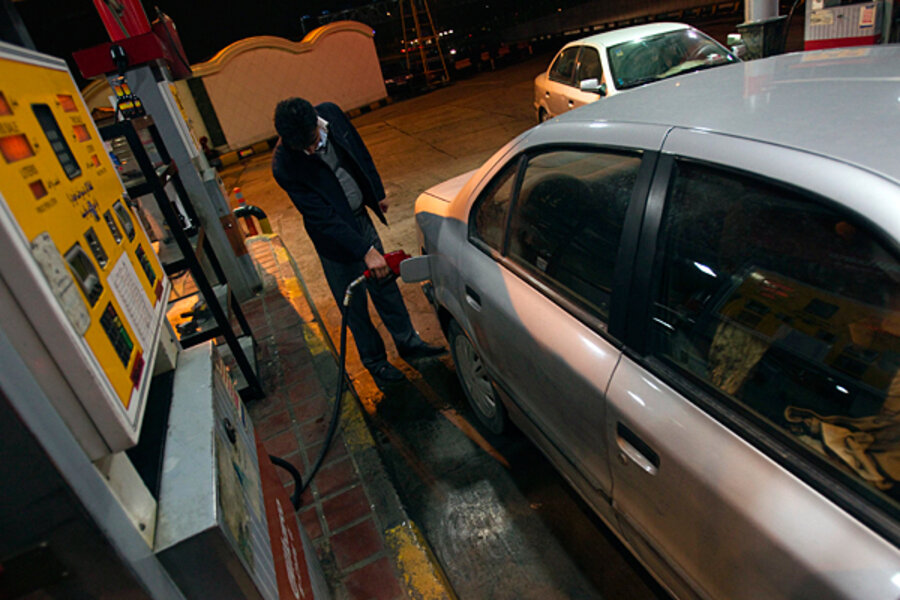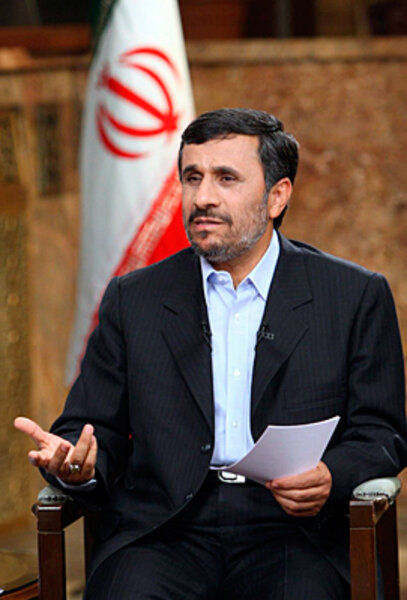Ahmadinejad cuts Iranian subsidies, quadrupling the price of gas
Loading...
Iran began taking dramatic steps over the weekend to remove subsidies on fuel, food, and other essentials, in a politically risky move that overnight quadrupled the price of gas and increased the price of diesel ninefold.
President Mahmoud Ahmadinejad said the ambitious plan was a critical step in dealing with Iran’s ailing economy – burdened by both mismanagement and four rounds of United Nations sanctions – and promised that the compensation scheme of $40 per person per month would benefit 60 percent of Iran’s population.
While many recognize the huge cost the subsidies have imposed on the economy – the government says it spends $100 billion every year, though experts suggest it could be one-third that – there has also been strong criticism, including from economists, politicians, and citizens.
RELATED: Why Iran's Ahmadinejad is pushing to cut popular government subsidies
Riot police were deployed at some gas stations in Tehran on Sunday to prevent a repeat of the 2007 violence and protests that came after fuel rationing was announced – stealthily, and late at night. So far there have been no reports of unrest due to the long-expected plan.
“I ask the people not to hoard gasoline because it carries many dangers. God forbid, accidents could happen,” Mr. Ahmadinejad said on live television, when announcing that the first phase of subsidy cuts would begin on Sunday.
The Iranian president invoked the Shiite Messiah, the Mahdi, when describing the compensation plan, noting that two months’ worth had already been deposited into personal bank accounts to be withdrawn from Sunday onward.
“This scheme will continue and will continue for decades, thanks to the divine wisdom, so no one can annul it,” Ahmadinejad claimed. “The people should not hurry in withdrawing this money [or] the market will be disturbed.”
'Ahmadinejad is the right person to do it'
Iran has provided costly state subsidies since the 1979 Islamic revolution. The effort to reduce them has long been a political hot potato. But Ahmadinejad, who has relatively strong backing among those most likely to be affected, has said he hopes to wean Iranians off the subsidies completely by the end of his term in 2013.
“Ahmadinejad is the right person to do it, because the brunt of this adjustment is going to be felt by people below the median income, especially when you get into bread, maybe even medicine,” says Djavad Salehi-Isfanhani, an economist at Virginia Tech and a fellow at the Brookings Institution, contacted in Tehran.
Such Iranians, often called the “pious poor,” have formed the backbone of the populist president’s support since Ahmadinejad was first elected in 2005. Many still support him, despite the disputed reelection in 2009, and the arch-conservative president has taken some unpopular decisions while at the same time enhancing the power of the president’s office.
“He said, ‘I am with the people, I am for the people,’ he kept saying that,” notes Mr. Salehi-Isfahani. “He was so emphatic about the fact that they thought about everything… ‘We know about the truck drivers who operate there,’ it was a confidence-building speech.”
37,000 clerics deployed to make the case
But experts are uncertain about the impact or success of the subsidy reforms, as well as of the ability of the government – which has shown “sheer incompetence” in some economic issues, says Salehi-Isfahani – to carry them out. Making the cash deposits in advance, however, was “very clever” because it helped counter the deep-seated belief that "the government is a thief,” he adds.
“This is a very hard country to govern, because there is so much distrust of government,” says Salehi-Isfahani. “With this level of distrust, to figure out a way to give and take at the same time is a good thing. [But] I’m not at all confident that they have thought a lot of things through.”
One Iranian website claimed that 37,000 clerics had been deployed across Iran by the Islamic Propaganda Organization to help make the case for the changes, according to the Enduring America website, which monitors Iranian media.
Economist Fariborz Rais Dana was arrested in Tehran soon after an interview with the BBC Persian service, in which he said: “The government knows the cash that it gives to people will evaporate under inflationary pressure. Thus, after a while the cash will have no effect. The government will get rid of the huge expense [of the subsidies] and will spend the money on buying weapons or other things, and people will be on their own.”
Removing the subsidies, he said, according to a translation by analyst Muhammad Sahimi on the Tehran Bureau website, “will create more unemployment, more poverty, and more misery.”
President tackles culture of waste
Cut-price essential services have been a fact of life in Iran since the revolution. On his first day back in Tehran from exile in February 1979, Ayatollah Ruhollah Khomeini, the father of the revolution, stated that the Islamic Republic would “provide you water and electricity and bus rides free of charge,” and even “build a home for you.”
IN PICTURES: Scenes from Iran's Islamic Revolution
But the heavy subsidies have encouraged a widespread culture of waste in Iran. Economists say too many cars in Tehran, for example – and the attendant severe air pollution and traffic – are partly a function of gas that until now has been far cheaper than bottled water.
The price of gas, for example, has risen from 10 cents a liter to 40 cents. The price of electricity is set to triple, the cost of water to quadruple, and the price of flour to rise 12-fold.
Sometimes Iranians keep their cooking gas burners on constantly, even if there is no kettle or pot on the stove; reports suggest one of the highest volumes in the region of bread thrown away – part of a subsidy that costs the government $4 billion each year, according to Ahmadinejad.
“We have [planned to increase] the price of water, electricity, and natural gas gradually so everyone has an incentive to be more economical,” Ahmadinejad said on state TV.
'Ahmadinejad is a national hero'
Iranians are uncertain that such monumental economic changes will improve an economy already facing high levels of inflation and four sets of United Nations Security Council sanctions over Iran’s uranium enrichment program.
Television news reports showed some taxi drivers angry with the price hikes that will hit their business hard. But at least some are pleased.
“Ahmadinejad is a national hero,” said a 56-year-old taxi passenger quoted on the Tehran Bureau website. “He is the man who will lay the foundations for a new Iran. Everything he says is word for word our grievances. Why should the people in north Tehran live so well while all of us are being crushed by the hardships of life?”






